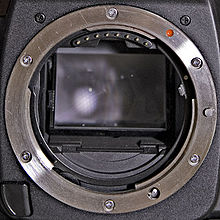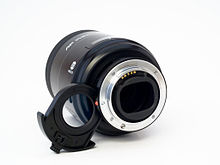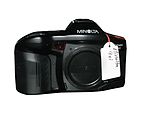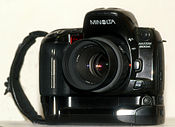- Minolta AF
-
The Minolta Alpha camera system was a collection of photographic equipment from Minolta. The system used a lens mount called A-mount, with a flange focal distance 44.50 mm. The new mount was larger than the older SR-mount making old manual lenses incompatible with the new system. The mount is now used by Sony, who bought the SLR camera division from Konica Minolta, Konica and Minolta having merged a few years before.
The Minolta AF system was at first marketed as Maxxum in North America and Alpha (or α) in Japan and the rest of Asia. In Europe early Minolta AF cameras were initially identified by a 4 digit number followed by AF. The name Dynax was introduced later with the "i" cameras, the second generation of Minolta AF camera.
It was originally based around a selection of three 35 mm single-lens reflex (SLR) bodies, the 5000, 7000 and 9000. The system also included an extensive range of auto-focus lenses, flashes, a motor drive and other accessories. Compatible equipment was made by a number of third parties.
In the following years, many different cameras and accessories were added to the range.
The last film-based Alpha AF SLRs produced by Minolta were the Maxxum 50 (AKA Dynax 30 and Dynax 40) and the Maxxum 70 (AKA Dynax 60 and Alpha 70), built in China. The Dynax/Maxxum/α branding was also used on two Konica Minolta digital SLRs, prior to the acquisition by Sony (7D, 5D).[1][2]
When Sony acquired Konica Minolta's camera technologies in 2006 they chose the "α" brand name (already in use by Minolta in Asia) for their new "Sony α" digital SLR system. The Dynax/Maxxum/Alpha lens mount (which was retained from the old cameras) is now officially known as the "α mount system" or "Alpha mount system".[3]
Contents
First generation
Bodies
7000
The Minolta 7000 was the first successful auto focus SLR using a motor integrated in the camera body. It was released in 1985 together with 11 lenses, 2 flashguns and a complete lineup of accessories. The 7000 featured one AF-sensor, shutter speeds of 1/2000 to 30 seconds, flashsync speed of 1/100s, exposure compensation of +-4EV in 0.5 exposure steps, center-weighted lightmetering and two frames per second film advance.
9000
The Minolta 9000, a camera aimed at professionals, was released later the same year, and featured shutter speeds of 1/4000 to 30 seconds, center-weighted and spot lightmetering, exposure compensation of +-4EV in 0.5 exposure steps and a flashsync speed of 1/250s. Unlike the 7000, the 9000 had no internal motordrive and thus holds the position as the world's only autofocusing SLR with manual winding, but with the addition of the motor drive MD-90 you could get up to 5 frames per second. The 9000 had a very extensive range of accessories, including several different backs, winding options and screens.
5000
The Minolta 5000, Minolta's entry level camera and essentially a downscaled 7000, was released in 1986. It featured shutter speeds of 1/2000 to 4 seconds and BULB, center-weighted lightmetering, exposure compensation of +1EV, flashsync speed of 1/100s and fully automatic programs.
Second generation
Bodies
7000i
This camera had the usual Program automatic exposure, Shutter priority automatic exposure, Aperture priority automatic exposure and metered manual exposure modes (standard on the 7000), TTL autoflash (like the 7000) and added a newer faster and more sensitive AF system, faster film advance, new flash hot-shoe that was incompatible with the older flash system (although an adapter was available and the 7/8000i supported the x000-era CG-1000 "flash handle" for backwards compatibility). The 7000i supported the Maxxum lens system, and other previously introduced accessories such as the remote cords. Perhaps more innovative and unusual than any other improvement was the expansion card system. While also used in other models in the i-series, some models in the xi-series, and the 700si, the Minolta Creative Expansion Card System debuted on this model. The expansion card system provided a way to add features to the camera, such as multi-spot metering, or re-program the built-in AE modes to favor faster shutter speeds or smaller apertures, such as the sports action card. While most of the cards' functions and effects could be duplicated by a technically knowledgeable photographer using the camera without the expansion cards, the card system was handy for less technically skilled users who just wanted to photograph their child's soccer/football team for example, without needing to learn about exposure settings and the effect they might have on how a picture "looked". These cards were the forerunners of today's "picture/creativity modes". This camera was aimed at the same market as the 7000.
5000i
Built-in flash with a zoom head, programmed AE and metered manual exposure out of the box, adding the A/S expansion card provided two additional AE modes, Shutter-priority and Aperture-priority. A fairly direct replacement for the earlier 5000.
8000i
Essentially added a PC flash-sync terminal, ME capability, spot metering and faster shutter to the 7000i feature-set. This camera was not a direct replacement for the earlier 9000, and lacked some features such as depth-of-field preview, but offered some additional features that were not on the 7000i. This camera was available in white as well, together with matched white 35-105 lens and 5200i flash.
3000i
An entry level camera, exposure mode was program AE only, with a high-speed program option, no Creative Expansion Card support. An even more basic Maxxum, this camera was basically for the point-and-shoot user that wanted a system SLR camera with interchangeable lenses and more powerful flashes, but didn't want the features on, or didn't want to pay for, the 5000i, 7000i, 8000i cameras.
Third generation
Bodies
2xi
An entry-level model, the plastic-bodied 2xi features a program mode (p-mode), Shutter priority mode(s-mode), aperture priority mode(a-mode), and fully manual mode(m-mode). There is also a self timer feature, a manual / auto focus switch for use with the series of auto focus lenses, hot shoe mount compatible with i and xi flashes, and a tripod mount.
3xi
QTsi
GT
5xi
7xi
9xi
The Minolta 9xi was the flagship of the xi series cameras.
Fourth generation
Bodies
600si
The Minolta 600si Classic (aka Maxxum 600si and alpha 507si), introduced in 1995, featured classic controls for most functions. This meant that the 600si had many dials and knobs rather than a menu system. The top plate of the camera included separate dials for exposure compensation, flash compensation, exposure mode and drive mode, and other functions were controlled by further knobs elsewhere. The advantage to the photographer was that almost all settings were readily identified even when the camera was not switched on - just like a classic camera.
The 600si did not have a P (panic) mode to reset all functions, nor was it possible to store favourite combinations of settings or use cards from the 700si card system. The 600si could be used with the VC-600 vertical control grip for a second set of controls and additional battery options.
650si
The 650si was effectively a 600si with the addition of date/time imprinting and a built in panorama mask, restricting the film image to 12mm x 36mm.
700si
800si
The Minolta 800si, released in 1997, was the flagship of the si series cameras before the 5th generation single digit series. It can be seen as a stop-gap measure to fill the "advanced amateur" niche between the 1993 700si and the 2000 Dynax 7. This camera has a very high powered pop-up flash, one of the most powerful built-in flashes ever made. The 800si added a lot more features over its predecessor the 700si, at the expense of the 700si's card system, which most consumers at this time considered of little use due to the widespread integration of features into camera bodies. The 700si's vertical control grip, the VC-700, can also fit the 800si.
Fifth generation
9
The Alpha/Dynax/Maxxum 9, Minolta's last professional film body, was released in 1998 and started the 5th and final generation of their 35mm autofocus camera line. The camera is constructed with a zinc and aluminium cast frame covered by SUS304 stainless steel panels, uncommon for cameras, and can tolerate large amounts of abuse at the expense of some added weight. A vertical control grip (VC-9) mirroring the cameras basic controls was available. The camera had a maximum shutter speed capability of 1/12000 second due to carbon-fiber reinforced shutter blades, and a maximum frame rate of 5.5 frames/second. The camera just preceded the release of the SSM (SuperSonic Motor) lenses and D distance encoded lens/flash system, and as a result an upgrade was available in order to support the SSM lenses and D function. This upgrade was in the form of a complete systems board, unlike digital cameras which are usually upgradeable by software. Like all autofocusing Minolta SLR cameras it used the Minolta 'A-series' bayonet lens mounting system.
Also a titanium version of this camera was available as the 9Ti. The 9Ti had the same features as its regular counterpart with the exception of the silver finish, lighter weight and added strength of the titanium shell, and also received four additional custom functions for a total of 25. This camera came out in 1999 and in limited quantities.
The 9 was the first Minolta to use a radically different user layout, with lots of buttons, instead of the "computerized" interfaces tried earlier especially in the i and xi series. The more classic interface was first "tested" in a si series camera, the 600si Classic (which in essence was a 700si with a different interface) and garnered positive response. This interface was then refined and proved to be a major hit with consumers and reviewers alike, was largely copied over to the Konica Minolta Maxxum 7D, and also kept in later advanced amateur/professional Sony digital cameras. The vertical control grip was also the first to feature a slightly lowered handgrip and shutter button, for better ergonomy in vertical shooting. This style of grip has also been featured in later Minolta and Sony models.
- See also: Minolta Maxxum 9 (de)
7
The 7 is generally considered even more advanced in many respects than the Alpha/Dynax/Maxxum 9, making it the most advanced Alpha/Dynax/Maxxum. Amongst its many unusual features, it had a function which could emulate the 135 mm STF (Smooth Transition Focus) lens by doing multiple exposures while varying the aperture—something never done neither before nor since. The 7 was the first camera to support SSM lenses. Perhaps most noteworthy and radical was a huge LCD navigation display on the rear of the camera's film door. This offered a full operational view without the need of constant referral to the operating manual. It also eased operation of the 35 custom functions to change camera settings. Also, the 7 featured a plethora of dials and buttons as opposed to the "hold button while turning wheel" interface many of its other contemporaries offered. This interface was a direct evolution from the 9 and 600si Classic and later continued in other pro- and semi-pro models.
This Maxxum offered the maximum shutter speed of 1/8000, a maximum frame rate of 4 frames/second, autofocus control with a 16-bit CPU coupled with a 14-segment honeycomb-pattern metering and the support of Minolta's ADI (Advanced Distance Integration) with its "D" series lenses. Also for the professional–enthusiast was the vertical control grip (VC-7) that replicated some basic controls for vertical shooting and extending shooting time with extra batteries. There was also a film chamber lock to avoid accidental exposure of film that is still loaded. The Alpha/Dynax/Maxxum 7 was noted to be a good camera among many photographers and rave reviews on the Internet and magazines alike.[citation needed]
5
The 5 was an easy-to-use, compact, and feature-packed film camera using core technologies from the Minolta Alpha/Dynax/Maxxum 7. The Alpha/Dynax/Maxxum 5 incorporated advanced autofocus (AF) technology, powerful film drive, relatively fast shutter speeds, and several creative features including 14 custom functions, into a small and light silver-colored SLR camera body. Like all other autofocus Minolta cameras, it used the same lenses initially offered in the mid-1980s. Also available was a battery grip (BP-200) for extended 35 mm film shooting.
The Maxxum 3 and Maxxum 4 are based on this Minolta, being less feature-rich entry-level cameras. This fifth generation (Alpha/Dynax/Maxxum 3/4/5, 7 & 9) were the last full generation of film cameras that Minolta made with only two more film cameras (Aplha/Dynax/Maxxum 60 and 40) produced before merging with Konica and leaving the 35 mm camera business all together.
Sixth generation
40
First of two sixth generation Minolta film cameras. Entry level camera which took the crown as lightest and smallest 35mm SLR.
Digital SLR bodies
5D
7D
Sony α DSLRs and SLTs
Including the SLT-A33, SLT-A35, SLT-A55, SLT-A65, SLT-A77, DSLR-A100, DSLR-A200, DSLR-A230, DSLR-A290, DSLR-A300, DSLR-A330, DSLR-A350, DSLR-A380, DSLR-A390, DSLR-A450, DSLR-A500, DSLR-A550, DSLR-A560, DSLR-A580, DSLR-A700, DSLR-A850, DSLR-A900:
Lenses and tele-converters
Designations
- DT - "Digital Technology", lenses for APS-C size digital sensors
- APO - Apochromatic lens element(s)
- G - "G Series", professional lenses
- SSM - "SuperSonic Motor", in-lens ultrasonic motor used on some long telephoto G Series lenses. Autofocus will work with all digital Konica-Minolta and Sony bodies and 7, 5, 4, 40/60 and 9 (with service firmware upgrade) 35 mm film bodies.
- D - "Distance Integration", lens provides subject distance information for utilization in the Advanced Distance Integration (ADI) flash mode
- xi - Motorized Zoom
- STF - "Smooth Transition Focus", lens contains a special element which makes transitions between in and out of focus areas very smooth. This gives a Bokeh of the highest quality.
- SAM - "Smooth Autofocus Motor"
Revisions
The designations below are for the most part a product of the user community, and not necessarily used by Minolta.
- Original - Self explanatory
- RS - Restyled (aka "New"), aesthetic changes, and possible faster focus or addition of D feature.
- HS - "High Speed", upgraded gearing for faster autofocus, revised like a new model. Some lenses were upgradeable in authorized service centers as well.
- II - Some lens underwent more than just cosmetic changes, and are referred to as second version.
- Sony - Lens designs under the Sony label, some aesthetic changes including the focus and/or zoom grip. Most of these lenses are re-badged RS lenses, with the exception of the Carl Zeiss lenses which are of a new design. Some have a different coating formula which is optimized for digital sensors.
AF zoom lenses
- Carl Zeiss Vario-Sonnar T* 16–35 mm f/2.8 ZA(Sony SSM motor)
- AF 17–35 mm f/2.8-4 (D)
- AF 17–35 mm f/3.5 G
- AF 20–35 mm f/3.5-4.5
- AF 24–50 mm f/4 (Original, RS)
- AF 24–70 mm f/2.8
- Carl Zeiss Vario-Sonnar T* 24–70 mm f/2.8 ZA(Sony SSM motor)
- AF 24–85 mm f/3.5-4.5 (RS, II)
- AF 24–105 mm f/3.5-4.5 (D, Minolta)
- AF 24–105 mm f/3.5-4.5 (D, Sony)
- AF 28–70 mm f/2.8 G
- AF 28–75 mm f/2.8 (D)
- AF 28–75 mm f/2.8 (D Sony ASM motor)
- AF 28–80 mm f/3.5-5.6 (RS, D)
- AF 28–80 mm f/4-5.6 (xi, RS)
- AF 28–85 mm f/3.5-4.5 (Original, RS)
- AF 28–100 mm f/3.5-5.6 (D)
- AF 28–105 mm f/3.5-4.5 (RS, II)
- AF 28–105 mm f/3.5-4.5 xi
- AF 28–135 mm f/4-4.5
- AF 35–70 mm f/3.5-4.5 (Original, II)
- AF 35–70 mm f/4 (Original, RS, II)
- AF 35–80 mm f/4-5.6 (RS, xi, II)
- AF 35–105 mm f/3.5-4.5 (Original, RS)
- AF 35–200 mm f/4.5-5.6 xi
- AF 80–200 mm f/2.8 Apo G (Original, HS)
- AF 80–200 mm f/4.5-5.6 xi
- AF 70–200 mm f/2.8 APO SSM (G, Sony G)
- AF 70–210 mm f/3.5-4.5
- AF 70-210mm f/4 (nickname: beercan)
- AF 70–210 mm f/4.5-5.6 (RS, II)
- AF 70-300mm f/4.5-5.6 SSM (Sony G lens SSM motor)
- AF 70-400mm f/4-5.6 (Sony G)
- AF 75-300mm f/4.5-5.6 (Original, RS, D, Sony)
- AF 100–200 mm f/4.5
- AF 100–300 mm f/4.5-5.6 (RS, APO, APO D)
- AF 100–400 mm f/4.5-6.7 APO
DT Zoom Lenses
- AF DT 11–18 mm f/4.5-5.6 (D, Sony)
- AF DT 16–105 mm f/3.5-5.6 (D, Sony)
- AF DT 18-55mm f/3.5-5.6 (Sony SAM)
- AF DT 18-70mm f/3.5-5.6 (D, Sony)
- AF DT 18–200 mm f/3.5-6.3 (D, Sony)
- AF DT 18–250 mm f/3.5-6.3 (Sony)
- AF DT 55–200 mm f/4-5.6 (D, Sony, Sony SAM)
- Carl Zeiss Vario-Sonnar T* DT 16-80 f/3.5-4.5 ZA
Prime lenses
Standard Primes
- AF 50mm f/1.4 (Original, RS, Sony)
- AF 50mm f/1.7 (Original, RS)
- AF DT 50mm f/1.8 (Sony SAM)
Wide-angle Primes
- AF 16mm f/2.8 Fisheye (Original, Sony)
- AF 20 mm f/2.8 (Original, RS, Sony)
- AF 24mm f/2.8 (Original, RS)
- AF 28 mm f/2 (Original, RS)
- AF 28 mm f/2.8 (Original, Sony)
- AF 35 mm f/2.0 (Original, RS)
- AF 35 mm f/1.4 (Original, G, Sony)
Telephoto Primes
- AF 85 mm f/1.4 (Original, G, G D, G D Limited)
- Carl Zeiss Planar T* 85mm f/1.4 ZA
- AF 100 mm f/2.0
- AF 100 mm f/2.8 Soft Focus (SF)
- Carl Zeiss Sonnar T* 135mm f/1.8 ZA
- AF 135 mm f/2.8
- STF 135mm f/2.8 [T4.5] (RS, Sony)
- AF 200 mm f/2.8 APO G (Original, HS)
- AF 300 mm f/2.8 APO G (Original, HS)
- AF 300mm f/2.8 APO SSM G (Original, Sony)
- AF 300 mm f/4 APO G HS
- AF 400 mm f/4.5 APO G HS
- AF 500mm Reflex (RS, Sony)
- AF 600 mm f/4 APO G (Original, HS)
Macro Primes
- AF DT 30mm f/2.8 Macro (Sony SAM)
- AF 50mm f/2.8 Macro (Original, RS, D, Sony)
- AF 50 mm f/3.5 Macro
- AF 100mm f/2.8 Macro (Original, RS, D, Sony)
- AF 200 mm f/4 Macro Apo G
- AF Macro Zoom 1x-3x f/1.7-2.8
AF tele converters
- AF 1.4X Tele Converter (APO, APO II, (D), Sony)
- AF 2X Tele Converter (APO, APO II, (D), Sony)
- AF 2x M/A Converter-S (For use of manual lenses shorter than 300 mm on AF bodies)
- AF 2x M/A Converter-L (For use of manual lenses longer than 300 mm on AF bodies)
3rd party lenses
See also
- Background to the Minolta autofocus SLR range
- List of Minolta products
- Sony E Mount
- Minolta SR mount
References
- ^ Nakamura, Karen, News: Recent top-five camera sales in Japan, photoethnography.com. Article written 2005-02-14, retrieved 2006-12-14. (Note Maxxum/Alpha digital camera name in list).
- ^ Minolta Dynax 7D review, ephotozine. Article retrieved 2006-12-14. (Note Dynax digital camera name).
- ^ "Sony decides α as new brand for digital Single Lens Reflex (SLR) cameras" (Press release). Sony. 2006-04-20. http://www.sony.net/SonyInfo/News/Press/200604/06-033E/. Retrieved 2006-09-29.
External links
Categories:- Minolta lenses
- Minolta cameras
- Lens mounts
- Photographic lenses
- Sony Alpha DSLR cameras
Wikimedia Foundation. 2010.







